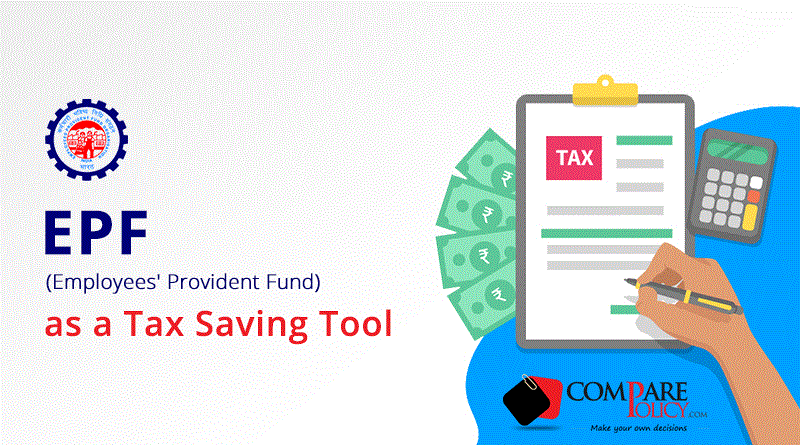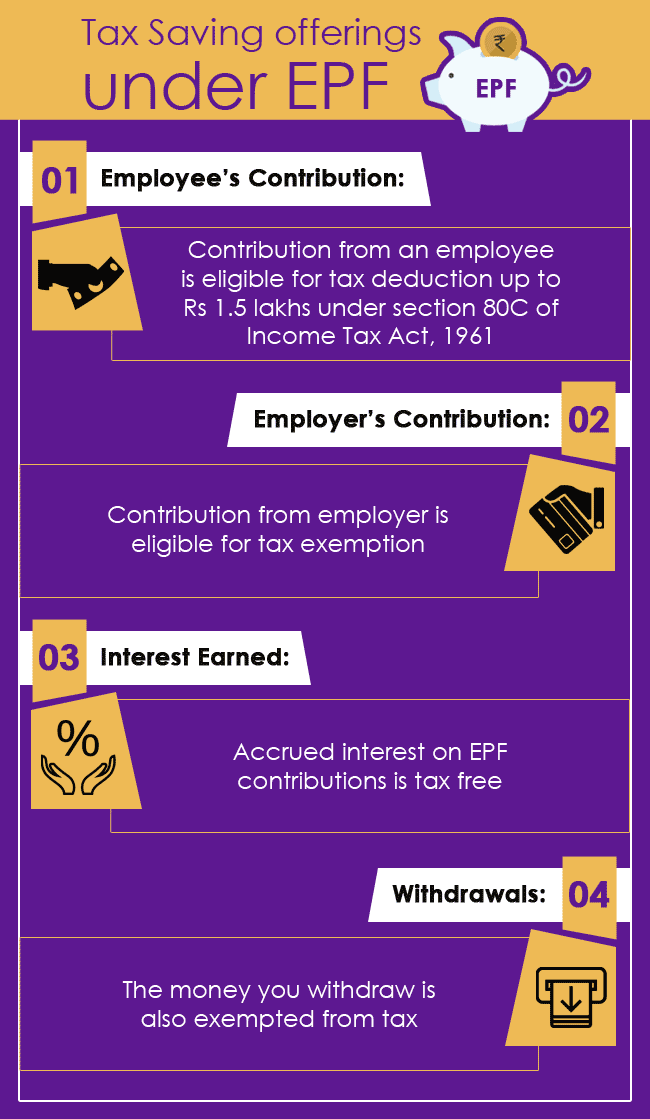EPF as a Tax Saving Tool
The Employees’ Provident Fund (EPF) is a retirement benefit scheme, available to all salaried people in India. It is a savings tool for the workforce. The EPF scheme is managed by the Employees’ Provident Fund Organisation (EPFO) under the Employees’ Provident Funds & Miscellaneous Provisions Act, 1952. The Employees’ Provident Fund Organisation (EPFO) administers EPF Scheme 1952, Employees Pension Scheme 1995 (EPS) and Insurance Scheme 1976 (EDLI).
Table Content
- Why you should Invest in EPF?
- Tax Benefits for EPF Investment
- Tax Deduction for Investment in EPF
- Tax Exemption
- Tax on Premature Withdrawals
- Key Aspects You should Know About EPF
- 1. Eligibility
- 2. Contribution
- 3. Diversion of Employer’s Contribution
- 4. Interest Rates
- EPF Rate of Interest Over the Last Five Years
- 5. Higher Voluntary Contribution
- 6. Withdrawal
- Withdrawal After 58 Years
- Withdrawal Before 58 Years
- Availing Advances under EPF
- Universal Account Number (UAN)
- Pensions
- Bottom Line
- Related posts:
Why you should Invest in EPF?
- The Employee’s Provident Fund (EPF) is a long term investment tool that ensures financial stability during your retirement days.
- It is a secured investment and provide guaranteed returns on your savings.
- EPF serves as a social security scheme that enables salaried people to save for their retirement phase.
- Investing with a small proportion of your salary (12% of basic salary) allows you to accumulate a huge corpus of wealth at the time of retirement. Your employer also contributes to your EPF account.
- EPF also offers tax benefits under Section 80 C of the Income Tax Act.
Tax Benefits for EPF Investment
Following are the tax benefits that you can avail, upon opting for EPF investment.
Tax Deduction for Investment in EPF
The employee’s contribution towards EPF is eligible for tax deduction under section 80C of the Income Tax Act, 1961. The maximum limit for tax deductions is up to Rs 1.5 lakhs. An Employee has to contribute up to 12% of your salary (basic salary plus dearness allowance).
| Suppose, you have an annual salary of Rs 3,00,000, you can contribute up to Rs 36,000 (12% of salary) and avail tax deductions. Upon contributing Rs 36,000 in EPF, you can simply deduct this amount from your taxable income. |
Moreover, the EPF Act also allows you to make VPF (voluntary provident fund) contribution over & above the 12% in EPF. The VPF contribution can also avail the benefit of a tax deduction under section 80C, within the overall annual ceiling of Rs 1.5 Lakhs.
Tax Exemption
You can avail tax exemption on the employer’s contribution, interest earned and the withdrawal amount as well.
- The employer’s contribution to your Employees’ Provident Funds account is tax-exempted. The employer needs to contribute at the rate of 12% of an employee’s salary (basic salary plus dearness allowance).
- The interest earned on entire Employees’ Provident Funds contributions (including VPF contributions) is also tax free.
- The money you withdraw is entirely exempted from tax, provided you withdraw the amount after a minimum lock-in period of 5 years.
Tax on Premature Withdrawals
In case you withdraw money before 5 years, the entire contribution (your contribution and your employer’s contribution) and the interest accrued will become taxable. Five years of service include the total years of service, not necessarily with the same employer.
| Tax Benefits in EPF | Impact of Withdrawal before 5 years | |
|---|---|---|
| Employee’s Contribution (including VPF) | Tax deduction under section 80C | The deduction claimed under section 80C becomes taxable |
| Employer’s Contribution | Tax free | Taxable as salary |
| Accrued Interest | Tax free | Taxable as other income |
TDS on withdrawing EPF balance will be deducted, when the withdrawal is more than Rs 50,000, w.e.f June 1st 2016. Earlier this withdrawal limit was Rs 30,000. 10% TDS will be deducted, when PAN is submitted. Otherwise, 34.608% TDS is applicable, when PAN is not submitted.
Key Aspects You should Know About EPF
Before you invest in EPF, it would be a wise move to understand its key aspects
1. Eligibility
As per rules, the EPF benefits are extended to establishments which has at least 20 employees. Once registered, a business can still continue with EPF scheme, even if the employee count falls below 20 persons.Under EPF, all employees (including contract, temporary and daily rated employees) whose monthly salary is less than or equal to Rs 15,000 at the time of joining is eligible to become a member of EPF scheme. However, an employee whose monthly salary is more than Rs 15,000 can also become a member by obtaining permission from the Assistant PF Commissioner.
2. Contribution
The contribution paid by the employee is 12% of basic salary, dearness allowance and retaining allowance. An equal contribution is also required to be payable by the employer.
| Suppose, you have the monthly basic salary (including DA and other allowances) of Rs 30,000, the employee’s monthly contribution would be Rs 3,600 (12% of basic pay) and the equal amount is contributed by your employer as well. |
The employee also has the option to contribute at a higher rate, but in such case employer is not liable to pay at such a higher rate.
The contribution is restricted to 10%, in case an establishment employs less than 20 employees, any sick industrial company as declared by the Board for Industrial and Financial Reconstruction, any establishment which has accumulated losses equal to or exceeding its entire net worth at the end of the financial year, and any establishment engaged in industries namely, jute,brick, coir and guar gum factories.
3. Diversion of Employer’s Contribution
The employee’s contribution is entirely added towards EPF, however, all of the employer’s contributions don’t go into EPF kitty. Out of the entire employer’s contribution, 8.33% is diverted to the Employees’ Pension Scheme (EPS) and the remaining 3.67% is invested in EPF.
The proportion of the employer’s contribution to EPS is calculated on Rs 15,000. It means, even if the employee’s salary is Rs 15,000 or more, the EPS contribution is Rs 1,249.50 (8.33% of 15,000) per month. The balance amount is invested in the EPF scheme.
| Contribution | Employee | Employer |
|---|---|---|
| Employees’ Provident Fund (EPF) | 12% | 3.67% |
| Employees’ Pension Scheme (EPS) | Nil | 8.33% |
4. Interest Rates
A fixed Interest Rate is applied under a financial year under EPS scheme. During financial year 2016-17, rate of interest on EPF is 8.65%.
EPF Rate of Interest Over the Last Five Years
| Year | Rate of Interest |
|---|---|
| 2016-17 | 8.65% p.a |
| 2015-16 | 8.80% p.a |
| 2014-15 | 8.75% p.a |
| 2013-14 | 8.75% p.a |
| 2012-13 | 8.50% p.a |
The interest is calculated on the basis of monthly balance at the end of the month. The accrued interest under the EPF account is entirely tax-free.
5. Higher Voluntary Contribution
The employee has the option to pay the higher contribution on a voluntary basis, above the fixed 12% of basic salary. You are allowed to contribute the entire salary towards VPF. You can increase your VPF contribution at any point during your employment. This Voluntary Provident Fund (VPF) contribution earns tax-free interest.
6. Withdrawal
You have the option to withdraw the EPF balance after 58 years, before 58 years or can get EPF advances as well.
Withdrawal After 58 Years
As per EPF Act, you can claim final PF settlement after attaining 58 years of age. The total EPF balance including your contribution & your employer’s contribution along with the accrued interest, is payable as a lump sum.
Withdrawal Before 58 Years
As, EPF balance is meant to fulfill your post-retirement needs, you should withdraw it after retirement.However, if you want to withdraw the full EPF amount before 58 Years owing to some financial contingency, you can do so after two months (60 days) of leaving the job. Along with PF amount, you can also withdraw the EPS amount, provided you are in service for less than 10 years.
| It is advisable to withdraw the EPF balance after five years of service, else your withdrawal amount will be considered as taxable amount in the year of receipt. When you switch the job, it’s advisable to transfer the balance to the new employer. In case, you switch the job after 2 years of service, it’s better to transfer the PF balance to the new employer and withdraw it only after 5 years of service. |
Availing Advances under EPF
You can avail advances by filling in form 31 and submit it to the EPFO through your employer. UAN based form 31 can also directly be submitted to EPFO, provided you have KYC compliant Universal Account Number, linked to your bank account. You can take EPF advances to fulfill your family’s financial needs at specific circumstances, such as purchase of real estate property, repayment of loan, treatment of illness, higher education of son/daughter, marriage of self/daughter/son/brother/sister, avail advance for buying a house, etc.
Universal Account Number (UAN)
- Universal Account Number (UAN) is allotted by EPFO to each of the PF contributing members. UAN acts as an umbrella for multiple member Id’s allotted to an employee by different employers.
- It aims to link multiple member Id’s to a single member. It helps a member to view details of all member Id’s linked under UAN.
- Its main objective is to get the KYC details of employees that will be tagged against respective UAN. It helps to reduce the dependency on the employer.
- In most cases, the employer provides the UAN and the employee only need to get it activated by providing KYC documents to the employer.
- In case, you are changing jobs and already have a UAN, you are only required to provide it to the new employer at the time of joining, so the employer can mark the new allotted member identification number to your already allotted UAN. In case you don’t have UAN, you can furnish the date of exit from your previous organization along with your previous PF number.
- UAN is mandatory for all employees and it will help managing the EPF account. It also makes PF transfer and withdrawals much easier than ever before.
Pensions
You can start receiving pension under EPS after rendering a minimum service of 10 years and attaining the age of 58 years. After attaining the age of 58 years, an EPF member can receive the pension while in service, however, he/she ceases to be a member of EPS automatically.You also become eligible to receive pension upon attaining the age of 50 years. Early pension (pension amount after 50 years, but before 58 years of age) is reduced by 4% for every year, falling short of 58 years.
Bottom Line
Employees’ Provident Fund (EPF) is a retirement benefit scheme and all salaried employees can contribute by saving a fraction of their salary every month that you can withdraw upon retirement, disability, sickness or unemployment. The contributions in EPF also earn interest. The EPF interest rate is 8.65% during financial year 2016-17, which ensures decent returns and help you to build a corpus that you can utilize to fulfill your post-retirement needs.
In addition to fulfilling your post-retirement needs, EPF also offers you tax benefits. The employee’s contribution is tax deductible up to Rs 1.5 lakhs under section 80C of the Income Tax Act, 1961. The employer’s contribution is tax-exempted. The interest earned on EPF contributions is also tax free. You can also avail tax exemption for the money you withdraw, after 5 years of service.


